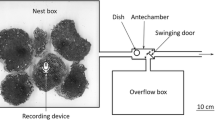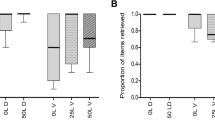Abstract
When ants are dispersing seeds (myrmecochory), cessation of foraging can be as important as recruitment in determining dispersal success. We studied food collection by Aphaenogaster rudis from experimental depots by monitoring temporal variation and preference in food removal (diaspores of Asarum canadense and Sanguinaria canadensis and larvae of Tenebrio obscurus). Removal of diaspores, but not insect larvae, declined to nearly zero over the scale of hours. Satiation extended over the scale of days for diaspores. Extensive collection of larvae inhibited future collection of diaspores, but the converse was not observed. Increasing distance from the nest reduced removal of diaspores, but not of food bodies isolated from diaspores. Removal rates for diaspores were uncorrelated with the number of workers or brood in a colony.
Similar content being viewed by others
References
Adams, E. S. (2003). Experimental analysis of territory size in a population of the fire ant Solenopsis invicta. Behav. Ecol. 14: 48–53.
Agosti, D., Majer, J. D., Alonso, L. E., and Schultz, T. R. (2000). Ants. Standard Methods for Measuring and Monitoring Biodiversity. Smithsonian Institution Press, Washington.
Beattie, A. J. (1985). The Evolutionary Ecology of Ant–Plant Mutualisms. Cambridge University Press, Cambridge, MA.
Beattie, A. J., and Culver, D. C. (1982). Inhumation: How ants and other invertebrates help seeds. Nature 297: 627.
Bever, J. D. (1999). Dynamics within mutualism and the maintenance of diversity: Inference from a model of interguild frequency dependence. Ecol. Lett. 2: 52–61.
Bono, J. M., and Heithaus, E. R. (2002). Sex ratios and the distribution of elaiosomes in colonies of the ant, Aphaenogaster rudis. Insectes Sociaux 49: 320–325.
Bresinsky, A. (1963). Bau, Entwicklungsgeschicte und Inhaltsstoffe der Elaiosomen. Studien zur myrmekochoren Verbreitung von Samen und Früchten. E. Schweizerbart'sche Verlagsbuchhandlung, Stuttgart.
Brew, C. R., O'Dowd, D. J., and Rae, I. D. (1989). Seed dispersal by ants: Behaviour-releasing compounds in elaiosomes. Oecologia 80: 490–497.
Burkhardt, J. F. (1998). Individual flexibility and tempo in the ant, Pheidole dentata, the influence of group size. J. Insect Behav. 11: 493–505.
Coovert, G. (2005). The Ants of Ohio. Ohio Biological Survey, Columbus, OH.
Dejean, A., Schatz, B., and Kenne, M. (1999). How a group foraging myrmicine ant overwhelms large prey items (Hymenoptera: Formicidae). Sociobiology 34: 407–418.
Detrain, C., and Deneubourg, J.-L. (1997). Scavenging by Pheidole pallidula: A key for understanding decision-making systems in ants. Anim. Behav. 53: 537–547.
Durier, V., Graham, P., and Collett, T. S. (2004). Switching destinations: Memory change in wood ants. J. Exp. Biol. 207: 2401–2408.
Franz, N. M., and Wcislo, W. T. (2003). Foraging behavior in two species of Ectotomma (Formicidae: Ponerinae): Individual learning of orientation and timing. J. Insect Behav. 16: 381–410.
Gordon, D. (1991). Behavioral flexibility and the foraging ecology of seed-eating ants. Am. Nat. 138: 379–411.
Gordon, D. (2002) The regulation of foraging activity in red harvester ant colonies. Am. Nat. 159: 509–518.
Hayes, A. F. (2000). Randomization tests and the equality of variance assumption when comparing group means. Anim. Behav. 59: 653–656.
Headley, A. E. (1949). A population study of the ant Aphaenogaster fulva ssp. aquia Buckley. Ann. Entomol. Soc. Am. 42: 265–272.
Heithaus, E. R., Culver, D. C., and Beattie, A. J. (1980). Models of some ant-plant mutualisms. Am. Nat. 116: 347–361.
Heithaus, E. R. (1981). Seed predation by rodents on three ant-dispersed plants. Ecology 62: 136–145.
Heithaus, E. R. (1986). Seed dispersal mutualism and the population density of Asarum canadense, an ant-dispersed plant. In Estrada A, Fleming T. H., Dirzo R., and Vasquez-Yanes S. C. (eds.), Frugivores and Seed Dispersal. Dr W. Junk Publishers, Dordrecht, pp. 199–210.
Holland, J. N. (2002). Population dynamics and mutualism: Functional responses of benefits and costs. Am. Nat. 159: 231–244.
Hölldobler, B., and Wilson, E. O. (1990). The Ants. The Belknap Press of Harvard University Press, Cambridge, MA.
Howe, H. F., and Miriti, M. N. (2004). When seed dispersal matters. BioScience 54: 651–660.
Kalisz, S., Hanzawa, F. M., Tonsor, S. J., Thiede, D. A., and Voigt, S. (1999). Ant-mediated seed dispersal alters pattern of relatedness in a population of Trillium grandiflorum. Ecology 80: 2620–2634.
Kay, A. (2004). The relative availabilities of complementary resources affect the feeding preferences of ant colonies. Behav. Ecol. 15: 63–70.
Kay, A. (2002). Applying optimal foraging theory to assess nutrient availability ratios for ants. Ecology 83: 1935–1944.
Keller, L., Passera, L. (1989). Size and fat-content of gynes in relation to the mode of colony founding in ants (Hymenoptera, Formicidae). Oecologia 80: 236–240.
Kjellsson, G. (1985). Seed fate in a population of Carex pilulifera L. I. Seed dispersal and ant-seed mutualism. Oecologia 67: 416–423.
Lanza, J., Schmitt, M. A., and Awad, A. B. (1992). Comparative chemistry of the elaiosomes of three species of Trillium. J. Chem. Ecol. 18: 209–221.
Lynch, J. F., Balinsky, E. C., and Vail, S. G. (1980). Foraging patterns in three sympatric forest ant species, Prenolepis imparis, Paratrechina melanderi, and Aphaenogaster rudis (Hymenoptera: Formicidae). Ecological Entomology 5: 353–371.
Marshall, D. L., Beattie, A. J., and Bollenbacher, W. E. (1979). Evidence for diglycerides as attractants in an ant-seed interaction. J. Chem. Ecol. 5: 335–344.
McGlynn, T. P., Shotell, M. D., and Kelly, M. S. (2003). Responding to a variable environment: Home range, foraging behavior, and nest relocation in the Costa Rican Rainforest Ant Aphaenogaster araneoides. J. Insect Behav. 16: 687–701.
Mercier, J.-L., and Lenoir, A. (1999). Individual flexibility and choice of foraging strategy in Polyrhachis laboriosa F. Smith (Hymenoptera, Formicidae). Insectes Sociaux 46: 267–272.
Morales, M. A., and Heithaus, E. R. (1998). Food gained from seed dispersal mutualism shifts sex ratios in colonies of the ant, Aphaenogaster rudis. Ecology 79: 734–739.
Ness, J. H., Bronstein, J. L., Andersen, A. N., and Holland, J. N. (2004). Ant body size predicts dispersal distance of ant-adapted seeds: Implications of small-ant invasions. Ecology 85: 1244–1250.
Nielsen, M. G. (2001). Energetic cost of foraging in the ant Rhytidoponera aurata in tropical Australia. Physiol. Entomol. 26: 248–253.
Portha, S., Deneubourg, J.-L., and Detrain, C. (2002). Self-organized asymmetries in ant foraging: A functional response to food type and colony needs. Behav. Ecol. 13: 776–781.
Ringel, M. S., Hu, H. H., and Anderson, G. (1996). The stability and persistence of mutualisms embedded in community interactions. Theor. Population Biol. 50: 281-297.
Sanders, N. J., and Gordon, D. M. (2002). Resources and the flexible allocation of work in the desert ant, Aphaenogaster cockerelli. Insectes Sociaux 49: 371-379.
Schatz, B., Lachaud, J. P., and Beugnon, G. (1999). Spatio-temporal learning by the ant Ectotomma ruidum. J. Exp. Biol. 202: 1897–1907.
Sheridan, S. L., Iverson, K. A., and Itagaki, H. (1996). The role of chemical senses in seed-carrying behavior by ants: A behavioral, physiological, and morphological study . J. Insect Physiol. 42: 149–159.
Skidmore, B., and Heithaus, E. R. (1988). Lipid cues for seed-carrying ants in Hepatica americana. J. Chem. Ecol. 14: 2185–2196.
Smith, B. H., DeRivera, C. E., Bridgman, C. L., and Woida, J. J. (1989a). Frequency-dependent seed dispersal by ants of two deciduous forest herbs. Ecology 70: 1645–1648.
Smith, B. H., Forman, P. D., and Boyd, A. E. (1989b). Spatial patterns of seed dispersal and predation of two myrmecochorous forest herbs. Ecology 70: 1649–1656.
Umphrey, G. J. (1996). Morphometric discrimination among sibling species in the fulva- rudis- texana complex of the ant genus Aphaenogaster (Hymenoptera: Formicidae). Can. J. Zool. 74: 528–559.
Weier, J. A., and Feener, D. H., Jr. (1995). Foraging in the seed-harvester ant genus Pogonomyrmex: are energy costs important? Behav. Ecol. Sociobiol. 36: 291–300.
Author information
Authors and Affiliations
Corresponding author
Rights and permissions
About this article
Cite this article
Heithaus, E.R., Heithaus, P.A. & Liu, S.Y. Satiation in Collection of Myrmecochorous Diaspores by Colonies of Aphaenogaster rudis (Formicidae: Myrmicinae) in Central Ohio, USA. J Insect Behav 18, 827–846 (2005). https://doi.org/10.1007/s10905-005-8743-3
Received:
Revised:
Issue Date:
DOI: https://doi.org/10.1007/s10905-005-8743-3




